Profile by Karen Delaney, January 2018
Nguyen Ngoc Thin, 54, joined the army in 1984, which means he does not receive compensation for AO exposure. He had five children – 1 died at the age of 3, and 2 died when they were 25 (they had cerebral palsy). The two remaining sons also have cerebral palsy.
The family tried to get compensation for AO. Mr. Thin tells me they did all the paperwork but were denied assistance as they can’t prove the conditions of the children were caused by AO. They only get compensation for persons with disabilities, which is 540k dong per month person ($45 total). I ask about Mr. Thinh’s health, and he tells me he has blurred vision, so he can’t read or write. He has also had polyarthritis – a pain in 5 or more joints. He tried to get AO compensation for himself but was denied.
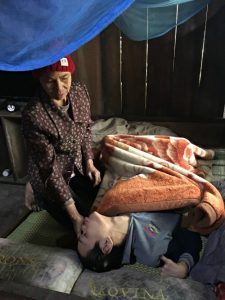 Mr. Thin had 600 chickens but they all died from diseases, which left them in tremendous debt. They also had 10 pigs, but now only two are left. Cao Thi Loan, 55, the mother, tells me they’ve tried to sell the remaining animals but they aren’t worth much and people are not interested. Mr. Thin doesn’t’ get much money from farming – just enough to feed his family. Mr. Thin had 600 chickens but they all died from diseases, which left them in tremendous debt. They also had 10 pigs, but now only two are left. Cao Thi Loan, 55, the mother, tells me they’ve tried to sell the remaining animals but they aren’t worth much and people are not interested. Mr. Thin doesn’t’ get much money from farming – just enough to feed his family.
When I asked about the sons, he tells me they are completely dependent on them. The youngest is laying down on a bed behind us. He keeps moaning. The mom goes over to calm him down. The other son is in the next room in a hammock. I’m told he cannot lay on the bed because he would roll out, so they keep him “tightly wrapped” in the hammock. Mrs. Loan tells me that their disability is physical, not mental, and they can both understand what people say. They can also recognize their parents and relatives. Nguyen Van Phan, 23, the youngest son, can say some words like “cold”, “hot”, but his mom tells me it is hard to understand him.
I ask about medication, and they tell me they only take it for “normal diseases” – flu, headache. There is no medication for cerebral palsy.
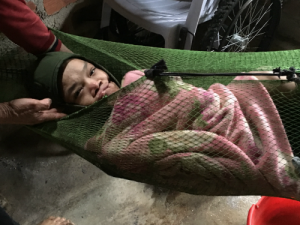 Mr. Thin says he would like to develop gardening and grow grapefruit. Ngoc tells me AP and AEPD could provide him with the seeds for this. Mr. Thin says he would like to develop gardening and grow grapefruit. Ngoc tells me AP and AEPD could provide him with the seeds for this.
I ask to take pictures of the children. The youngest, Nguyen Van Phan, keeps moving and moaning but doesn’t seem bothered by us there. The oldest, Nguyen Van Lan, 30, gets a bit agitated when we approach him. He has scars all over his face.
January 15, 2018
We go back to Mr. Thin’s house with Mr. Truong Mihn Hoc, the outreach worker, to create a business plan for the family. A neighbor joins us to write the business plan for Mr. Thin since he has blurred vision and can’t read or write himself. Ngoc tells me we cannot write for them, because the process needs to be transparent to the family and local authorities.
AEPD’s model is to empower families affected by Agent Orange, by giving them advice on how to improve their economic situation. The plan, however, comes from Mr. Thin, and AEPD gives them the tools to make it happen.
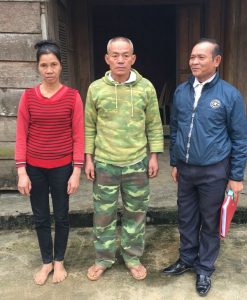 Mr. Thin says he would like to grow grapefruit to bring income to his family. Mr. Hoc asks him why he wants to grow fruit, rather than to raise an animal (a popular model for many AO affected families). He points out that there is plenty of grass around his house so it would be easy to feed the animal. Mr. Thin tells us that he raised animals for 5 years, but they all died and put him in terrible debt. Right after Ngoc translates this to me, his neighbor who is there to help receives a call to say that his pig has died. Mr. Thin laughs at the irony and explains that this is very common in this region, which is why he doesn’t want to raise cattle. Mr. Thin says he would like to grow grapefruit to bring income to his family. Mr. Hoc asks him why he wants to grow fruit, rather than to raise an animal (a popular model for many AO affected families). He points out that there is plenty of grass around his house so it would be easy to feed the animal. Mr. Thin tells us that he raised animals for 5 years, but they all died and put him in terrible debt. Right after Ngoc translates this to me, his neighbor who is there to help receives a call to say that his pig has died. Mr. Thin laughs at the irony and explains that this is very common in this region, which is why he doesn’t want to raise cattle.
Mr. Thin has 20 grapefruit trees in his backyard, so he knows how to take care of them. He tells us that the Government gives pieces of land to families living in mountainous areas, so they have 14 hectares of land 1 km away from their house. He tells us he would like to plant 500 trees there. He tells us that his area (Lam Hoa Commune), is famous for the low price of grapefruit, for many people come to buy the fruit. When I ask about competition, he says very few people sell grapefruit there, so he is confident that there would be demand. AEPD agrees that he has a model that works, and we should help him to expand it. The 20 trees don’t bring him a profit, but 500 would. He says his health is good enough to be able to manage the trees himself, without having to hire outside help.
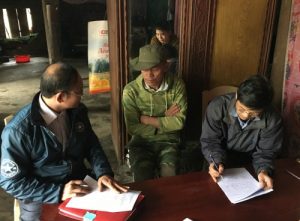 Once we agree that planting grapefruit is the best option for this family, Mr. Hoc starts talking logistics. He explains that it takes 3 years for the trees to give fruit, so that is when he would be getting the benefits. He also explains the risks of planting grapefruit – insects – and how to prevent them – planting garlic, chilli and neem leaves with the grapefruit. Moreover, Mr. Thin will need to buy fertilizer and equipment to water the plants. This all goes into the business plan. I am amazed at how much the outreach worker knows about the logistics of grapefruit specifically. Ngoc tells me the AEPD workers are very experienced, so they know the risk, benefits, and profits of different economic livelihood plans – from raising a cow to planting grapefruit. Once we agree that planting grapefruit is the best option for this family, Mr. Hoc starts talking logistics. He explains that it takes 3 years for the trees to give fruit, so that is when he would be getting the benefits. He also explains the risks of planting grapefruit – insects – and how to prevent them – planting garlic, chilli and neem leaves with the grapefruit. Moreover, Mr. Thin will need to buy fertilizer and equipment to water the plants. This all goes into the business plan. I am amazed at how much the outreach worker knows about the logistics of grapefruit specifically. Ngoc tells me the AEPD workers are very experienced, so they know the risk, benefits, and profits of different economic livelihood plans – from raising a cow to planting grapefruit.
Mr. Hoc explains that the first step would be to get a 20 million dong ($880) loan from the local “Social Policy Bank”, which has a low-interest rate. Ngoc explains to me that this is a government program that lends money to “the poor and vulnerable people” to start their business. AEPD’s good relationship with the local authorities guarantees a low-interest rate for Mr. Thin’s family. This money will be used to buy fertilizer, which is the first step in the grapefruit business plan. After that, Mr. Thin will depend on donors to get the seeds for the trees. AEPD, Ngoc tells me, never give a family the complete package. They give them the tools, to get the family’s commitment, before giving the financial assistance that buys the seeds, animal, etc. One of the outreach workers’ most important roles is to connect the families with local authorities and make them aware of available resources.
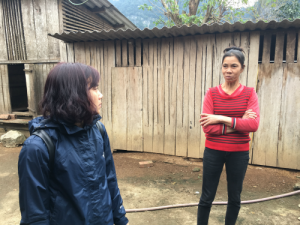 The calculations continue and Mr. Thin’s sister-in-law comes to do the writing since the neighbor had to leave. grapefruit, I’m told, has a stable price so it is unlikely that the price will drop. In the end, Mr. Hoc estimates that in 3 years, the family will make 268 million dong ($11,800), an average of 7.4 Million dong ($325) per month. The calculation counts on 300 of the 500 trees giving fruit. It is worth noting that the family won’t start making money until the third year. The calculations continue and Mr. Thin’s sister-in-law comes to do the writing since the neighbor had to leave. grapefruit, I’m told, has a stable price so it is unlikely that the price will drop. In the end, Mr. Hoc estimates that in 3 years, the family will make 268 million dong ($11,800), an average of 7.4 Million dong ($325) per month. The calculation counts on 300 of the 500 trees giving fruit. It is worth noting that the family won’t start making money until the third year.
In the end, Mr Thin’s sister-in-law reads the agreement out loud for Mr. Thin, who agrees with the commitment and signs the paper. He then takes the business plan to the local authorities for the approval stamp.
I take a few more pictures of husband and wife before leaving. Mr. Hoc asks for their permission to use the photos, which they grant us. He also explains that we can’t promise anything other than posting their stories and trying to get the support of donors. Mrs. Loan and Mr. Thin say they understand and then thank us once more.
Update by Marcela De Campos, July 2018
I had the pleasure of going on my first field trip on the fourth of July to the Tuyen Hoa district with Mr. Hoc (an AEPD Outreach Worker), Ngoc (AEPD staff), and Ashley and Seanin (summer interns from Canada). Our aim was to meet with the family of Nguyen Ngoc Thin—the tenth and latest Agent Orange Campaign beneficiary.
We arrived at Mr. Thin’s home around 10:00 am after a three-hour drive from Dong Hoi City. The air was hot, the landscape lush, and the raw cement floor refreshing. Mr Thin welcomed us into his home. He then shared the family’s experience and the plans he and Mr. Hoc had developed in January when Karen (Advocacy Project staff) met with them for the first time.
 Mr. Thin’s home Since Karen’s visit in January, Mr. Thin has been able to secure a loan for grapefruit and banana tree seeds and plant them. During this visit, the business plan was updated to reflect these accomplishments and determine estimated revenue, costs, profits, and the remaining need. The female cow’s manure will be used to fertilize the crops; the calf will be sold for income, as will the following seven calves she is expected to bear. The income from the calf sale and the crops will be used to support the household, purchase food and medicine, and begin repaying the loan.
Mr. Thin and Ms. Loan are the primary caregivers of their sons, Nguyen Van Phan (23 years old) and Nguyen Van Lam (30 years old). Their sons’ quality of life is severely impacted by their cerebral palsy associated with the couple’s environmental exposure to Agent Orange. They had five children, all with cerebral palsy. Lam and Phan are the surviving two. It is obvious that Mr. Thin and Ms. Loan cherish their sons, and do everything they can to preserve their dignity.
Unfortunately, the family is ineligible to receive government Agent Orange compensation because Mr. Thin joined the army after 1975. Instead, the family receives social assistance for persons with disabilities but it is not enough to maintain the household. Mr. Thin supports the family through agriculture; in addition to the 600 banana and grapefruit trees he has recently planted, he currently maintains 20 grapefruit trees and keeps two pigs. He mentions that while there has been no change in Lam and Phan’s health, he and his wife are aging and are no longer very healthy. Unfortunately, they are only able to access treatment in the local clinic because the hospital is far away and they cannot leave their sons alone.
 Mr. Thin, Nguyen Van Phan (23) (left), Nguyen Van Lam (30), and Ms. Loan. Lam and Phan spend most of the time in hammocks. This is the most secure place for them to stay. The family has found that they otherwise roll off beds and injure themselves. It allows Ms. Loan, as their primary caregiver, some peace of mind.
Lam is the oldest surviving son. His hammock is nearest the window. The sun gently beams against his skin as he sways n his hammock. I greet him as I approach and he repeats “Hello”. Ms. Loan mentions that he repeats sounds he hears but does not understand them. His eyes track the camera as we continue to engage with him, Phan, and Ms. Loan.
Mr. Thin had slipped out at some point during our conversation to obtain local authority approval for our visit. Mr. Hoc explains that we will meet him at the station. We say goodbye to them and see ourselves out. As we are leaving, I glance back at them and see Ms. Loan swiftly, yet gently, lifting Lam from his hammock on to the mat where she will feed him lunch. It feels so natural, so practiced and then I remember she has been doing this for the last 30 years.
It was a privilege to meet Mr. Thin and his family and I am thrilled to collaborate with them throughout my fellowship. AEPD and AP have launched a crowdfunding campaign to support Mr. Thin’s business plan.
August 22, 2018

This update documents the official exchange of the cow and calf between Mr. Thin’s family, Ms. Hue (the cow salesperson) and liaisons of the process (AEPD, AP, and Lam Hoa Commune’s Local People’s Committee).
As soon as we had raised the amount necessary to set Mr. Thin’s cow-rearing business plan in motion, Ngoc informed Mr. Hoc (AEPD Outreach Worker). Mr. Hoc then let Mr. Thin know it was time for him to get quotes for cows and calves from different salespeople in the region.
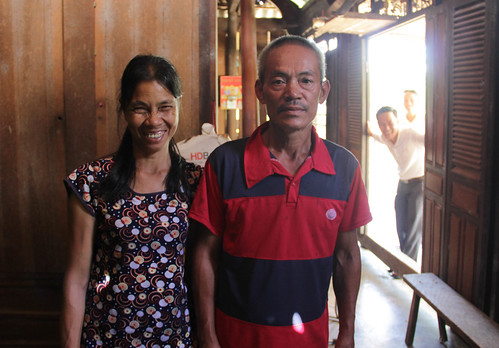
All Campaign beneficiaries are required to secure the resource(s) necessary to begin their business plan. The program’s model is set up this way to establish an additional layer of buy-in and to ensure that their resources (in this case, a cow and calf) are 100 percent suitable for the family’s needs. For example, Mr. Thin wanted a particular breed and size of a cow that would meet the fertilizer needs of his grapefruit and banana trees. The kind of grapefruit Mr. Thin is growing requires a larger quantity of manure.
Mr Thin received three quotes from local salespeople for two cows and a calf: 28 million VND ($1,200); 25 million VND ($1,072); and 23 million VND ($987). He chose a cow and calf that were most affordable and best suited for his needs for 23 million VND.
The cows had arrived when we reached Mr. Thin’s house. The family was so excited about the cow and the calf that Ms. Loan put Phan in his wheelchair and introduced him to the cow and calf. Phan was so elated upon seeing them that Ms. Loan put the rope in his hands. She told us that he tried to pull the cow and walk with her in his wheelchair. Lam, hearing the commotion outside, became agitated and Mr. Thin brought him out to see the new animals as well. He seemed equally thrilled, according to Mr. Thin.
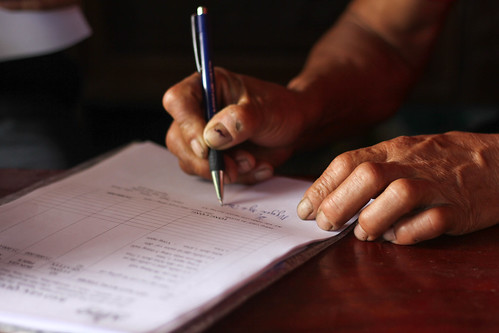
We entered their home to formalize the cow exchange and were met by Phan’s smiling face as he lay on the bed (rather than the hammock). Mr. Hoc facilitated the exchange and had Mr. Thin sign the contract and agreement between himself and AEPD. Mr. Tan witnessed the process and formally approved the purchase. Ms. Hue signed additional documentation and received the amount owed to her for the cow and calf.
The family has decided to use the cow and calf’s manure to fertilize their grapefruit and banana tree plantation. Mr. Thin intends to keep the cow and calf and continue to breed them. He will generate additional income by selling calves when he has a large enough herd. He confesses that they have made this decision because they “are thinking about [their family’s] future.” The income will be used for household expenses (food, medical supplies, doctor’s visits, etc.) and to help repay the loan he took out to plant grapefruit and banana trees. To add to the good news, the family’s grapefruit trees have already started to bear fruit and they have earned 4 million VND (approximately $170 USD) from selling grapefruits this summer.
Once every document had been signed and discussed, Mr. Thin led us to his field where Mr. Hoc officially handed over the cow’s rope. And with this swift gesture, Mr. Thin and his family were the official and rightful owners of a cow and calf.
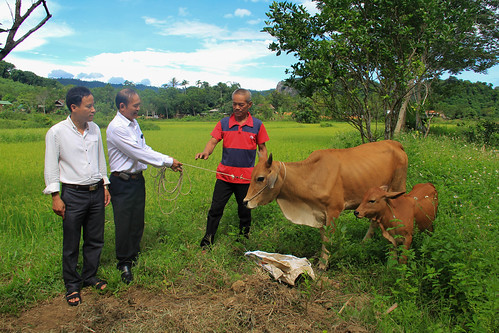
To ensure sustainability and longevity, we will continue to monitor and evaluate the Nguyen family’s progress as a result of their cow-rearing business plan; Mr. Hoc will continue to visit the family fairly regularly to check-in. We have high hopes for their success. Cheers to them, the Campaign, and to our donor’s kindness!
Update by Mia Coward, August 2019
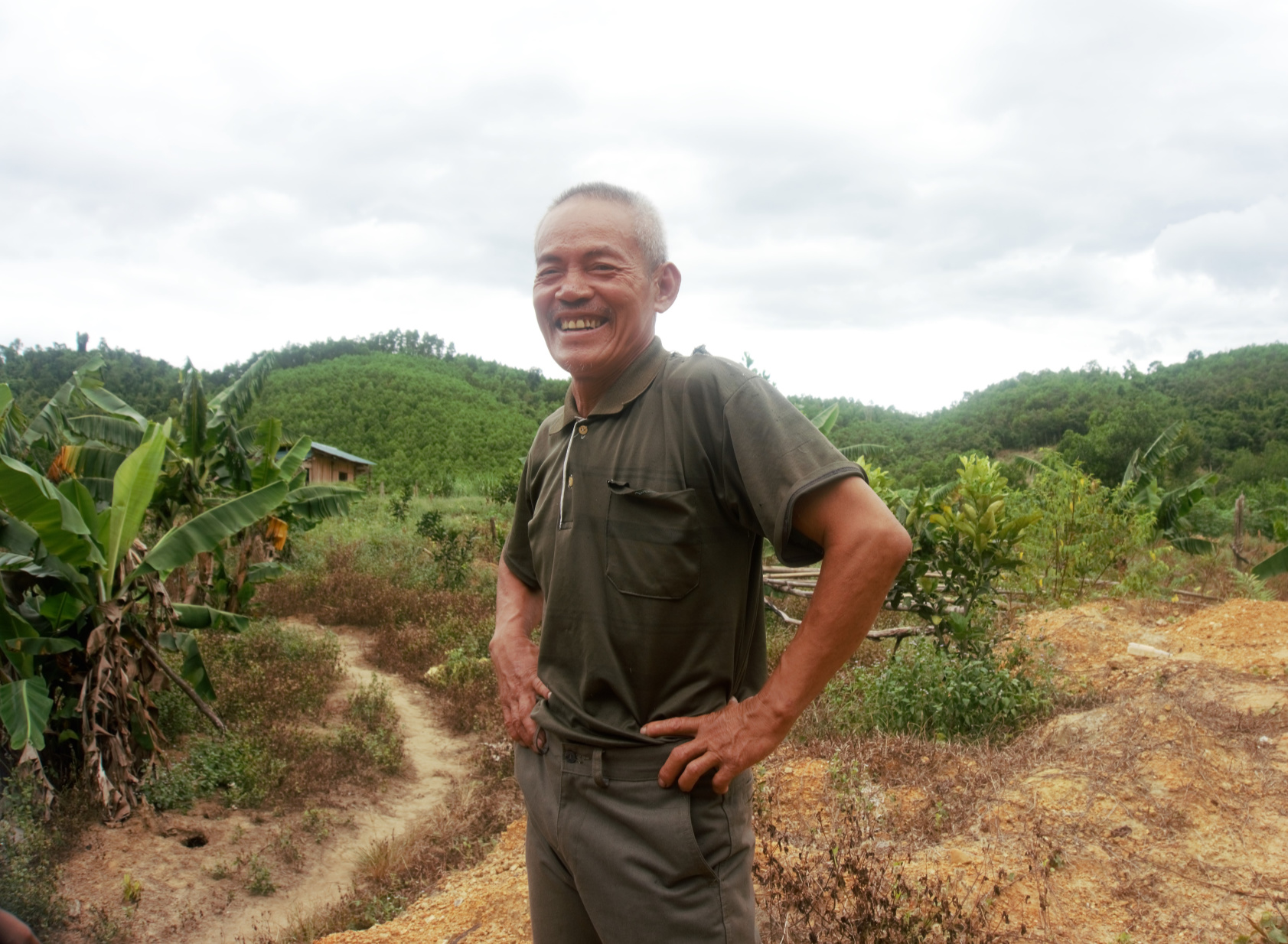 Mr. Thin is very proud of his garden After two hours of traveling, we arrive at Mr. Nguyen Ngoc Thin’s house on the way to the mountains. The air is dry but the sun is not so bad. Mr Thin and his wife Caos Thi Loan welcome us in his home. He is a very cheery man and full of laughter – indeed he makes jokes during the entire visit. His wife is much more reserved, a very quiet and sweet woman. She stays with the boys most of the conversation. There has been no change in their sons’ conditions since our last visit.
As mentioned in previous blogs, Lam and Nam are unable to walk or take care of themselves. They need to be washed every day, or their skin will develop a rash that can get infected. They are usually bathed together.
Earlier this year Mr.Thin was in an accident with a buffalo that almost caused him to go blind in his right eye. He went to the hospital in Hue and asked his siblings to help pay for travel (10M VND). The hospital cost was covered by health insurance. In March of this year, Mr Thin’s wife also went to the district hospital because of dry throat. The doctors wanted to transfer her to Hue, but the family decided against this because there would be no one to take care of her sons. The doctors also suggested she go to Hanoi to see another specialist. They are still debating if this will be possible.
As we chat, both sons are talking in the background and Mr. Thin jokes that one can understand English. When the conversation is over and we walk around to take pictures, I say hello to one of the sons. He responds with a smile and moves back and forth in the hammock. Mr Thin says they watch TV and are very protective of their mother.
Mr. Thin’s cows are healthy and growing well. The mother cow will give birth to a new calf soon, which would give him 3 cows in total. The calf that AEPD and AP provided him has not conceived yet but seems strong. Mr Thin is very excited to show us his grapefruit and jackfruit. Since there has been a drought, the grapefruit trees have not been as productive as usual but Mr.Thin is planting 700 new grapefruit and 50 jackfruit trees. It will take about 2 to 3 years for them to become fully productive. To watch over the farm, Mr Thin stays in a shed he has built about a kilometer from home. While he looks after the farm, his wife takes care of the pigs and chickens and their sons. Sometimes his nephew will come to help him in the farm.
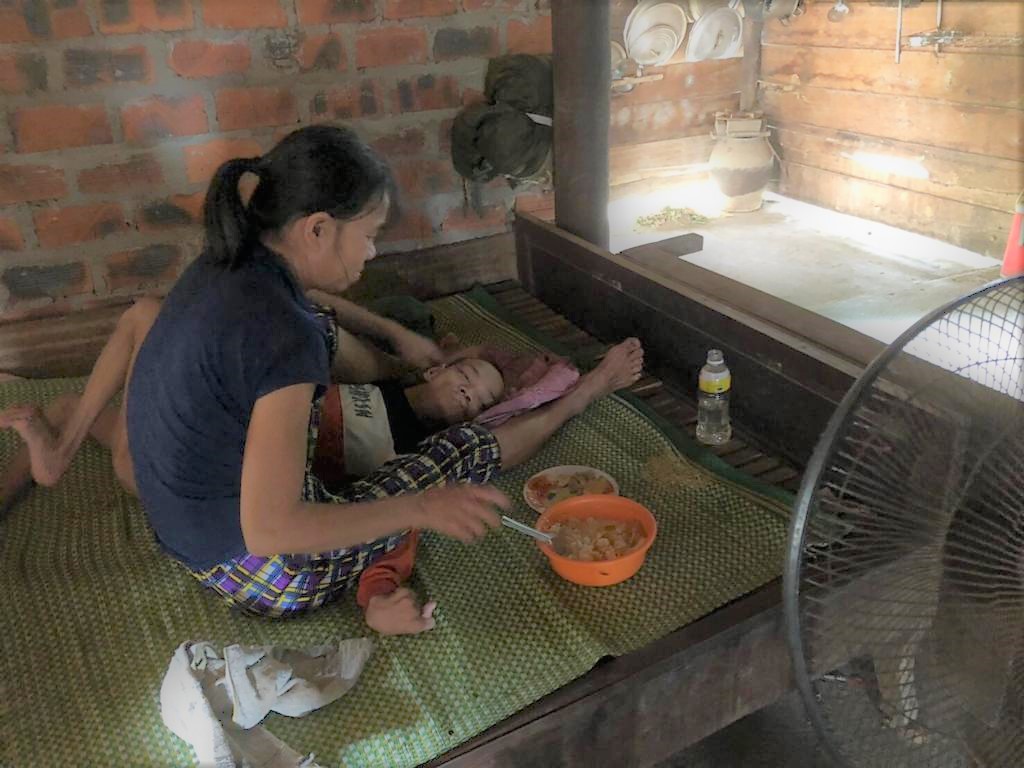 Ms. Loan with her son Nguyen Van Lam The family does not receive Agent Orange compensation because Mr. Thin worked on a border wall with China after 1975. By then the “American” war had finished, butthe poison from Agent Orange was still present in the air, water and food chain. Only those who fought in the American war qualify for AO compensation.
The family’s main source of income comes from a “social allowance” that is given for persons with disabilities and brings in 1,620,000 VND per month (for one caregiver and two sons). Mr Thin sells vegetables and chickens to supplement the family income and spends about 5M VND a month on food and medication. He gets a loan from the district government for the chemical fertilizer.
Since receiving the cow and calf, Mr.Thin has had to do more plowing and raising of the animals. Bu at least he has easy access to fertilizer (which was one of his original goals). Having cows also increases his capital, even if he has no immediate plans to sell the cows. He says that more cows will mean more fertilizer and more capital. Cows will also give him “credibility” with the banks, relatives, and neighbors and make it easier for him to get a loan. In addition to his farm, Mr Thin is also raising 12 pigs and 100 chickens. Once fully grown, they will sell for about 150 VND per chicken and 50 VND per kilo of pig.
I ask Mr. Thin which of the animals he prefers. He answers that cows are the best because he does not have to buy food and because they require less management. Chickens and pigs are also more vulnerable to disease. The flip-side of this is that pigs and chicks are less expensive and cost between 3 million VND and 13 VND compared to the 14M VND for a cow.
Mr. Thin has secured a loan from the bank for 30-40M VND, to buy chemical fertilizer. He does not have to pay interest but will have to repay the loan in about 3 years and is counting on the fruit, chickens and pigs to pay for it. We ask him if he would be interested in another loan, and he suddenly has a lot to say! He is interested but thinks that the loan should be for more than 50M VND, with a monthly interest of less 0.659%, repayable within 8 years. He would use the loan to grow his farm and cow-rearing business.
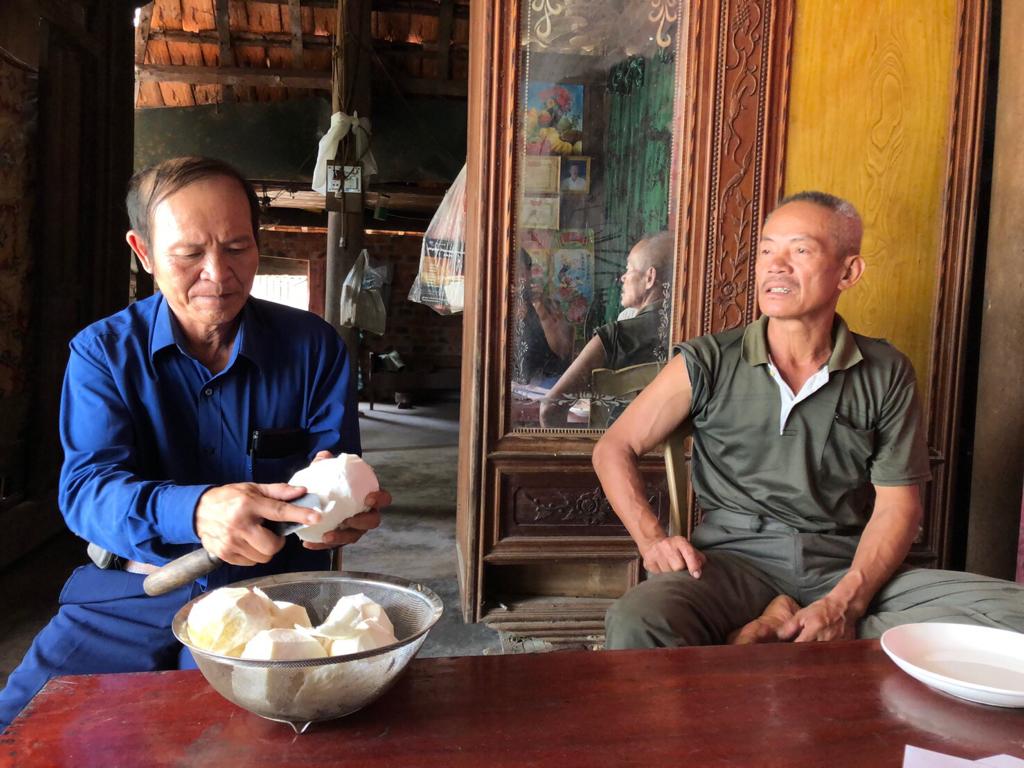 Mr. Thin with the AEPD outreach worker At the moment, Mr thin is not saving money and would not be able to contribute to a savings group. We ask if he would want to participate in a group grant or loan. He replies that this would be difficult at his age because the group would have strict requirements and set common goals, for example on interest rates. This might be easier if everyone was doing the same type of farming.
After taking pictures of the home and sons, we leave for the farm which is up a narrow dirt road heading into the mountains. Mr. Thin shows us the grapefruit and jackfruit. We did not get to see the animals since it was almost midday and they were resting under some shaded trees. Mr. Thin is proud of his farm and – like any entrepreneur – always looking for new opportunities. He is even thinking of raising some ducks in a small pond on the property.
|